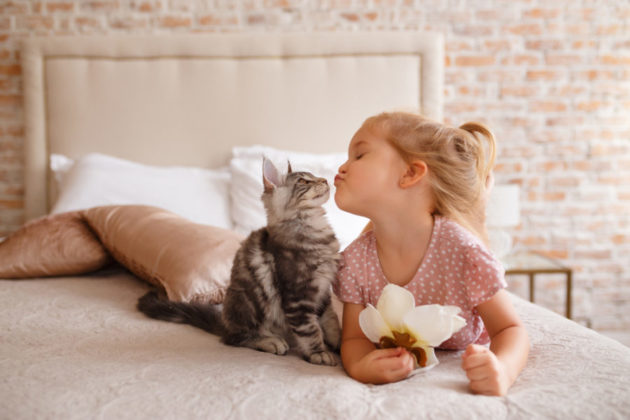
Contrary to the old saying that cats have nine lives, they’re actually fragile creatures. Tail pulling, hard petting and taunting can lead to bites and scratches. Sadly, when that happens, the blame is often put on the cat. Many kitties get labeled as ‘mean’ or ‘aggressive’ around kids, and are surrendered into shelters.
Kids are naturally curious. In their eyes, a kitty may appear to be a living, walking, stuffed animal. It is important to teach them there is a difference between stuffed animals and living creatures and, most importantly, that pets have feelings just like humans.
Feelings might be a hard thing for a toddler to understand. So here are some simple exercises to help build a trusting and healthy relationship between your child and cat. (Remember this is going to be an ongoing process, so be diligent with your supervision.)
Build Empathy
To help your children learn to respect your cat, start by teaching them that kitties have feelings too. Hunger is a feeling that we all share with our feline companions. When you sit down to eat with your family, ask your child if they think kitties get hungry too. Throughout the day, build the connection between their needs and the needs of your kitty’s. When you get a drink for your child, ask them if they think their kitty is thirsty too. Continue to do this and they will begin to connect the dots.
Introduce healthy handling habits
In my field of work, I’ve seen too many videos of kids roughly handling pets. Many times, the parents are the ones filming or photographing while calling that behavior ‘cute’. When introducing healthy handling habits between your child and cat, let your cat set the terms. Never leave a young child alone with a pet, and always praise your child — and the cat — when positive interactions occur!
Petting
We all know cats can be temperamental about their schedules and when they want to be touched, so never force a cat to be petted when it does not want to be. Instead, have the child hold treats or play with a cat toy to coax him. Once the kitty approaches and is in a friendly mood, then you can teach your child how to pet him properly.
A good rule of thumb is to let the kids stroke them on the back from head to tail. Be sure to correct them if they pet against the direction of their fur, as this can irritate the kitty.
It is also a good idea to bring attention to areas that should be avoided from contact like the tail, inner ears, and paws.
Holding
First, ask yourself if your cat likes to be held. If not, simply tell your child to never pick up the cat. Instead, instruct him or her to sit on the floor and have the kitty (if willing) sit in their lap.

Every kid is different, so there is not one age in particular when it becomes okay for them to begin holding pets. A good observance is if your kid is still using a sippy cup, because they spill and are not careful, then they are likely not ready to hold a cat – or any pet for that matter.
A fun exercise to help your child become conscious of handling pets is the pet egg challenge. I have our campers do this each year at Summer camp.
Have them paint or decorate an egg like a pet. Have fun and glue googly eyes and a tail on it. Have them name it and take pride in keeping their pet egg safe. The egg shell will break if they are not careful, which can be a great lesson for them.
Lead by example
You can celebrate National Respect Your Cat Day too by pledging to keep your pets for life. Millions of cats and dogs enter shelters each year. My goal as the Founder of the Pet Education Project is to lower that number by educating our future pet owners to be responsible and respectful! Teach your kids that animals aren’t disposable, and are as deserving of respect as we are!
